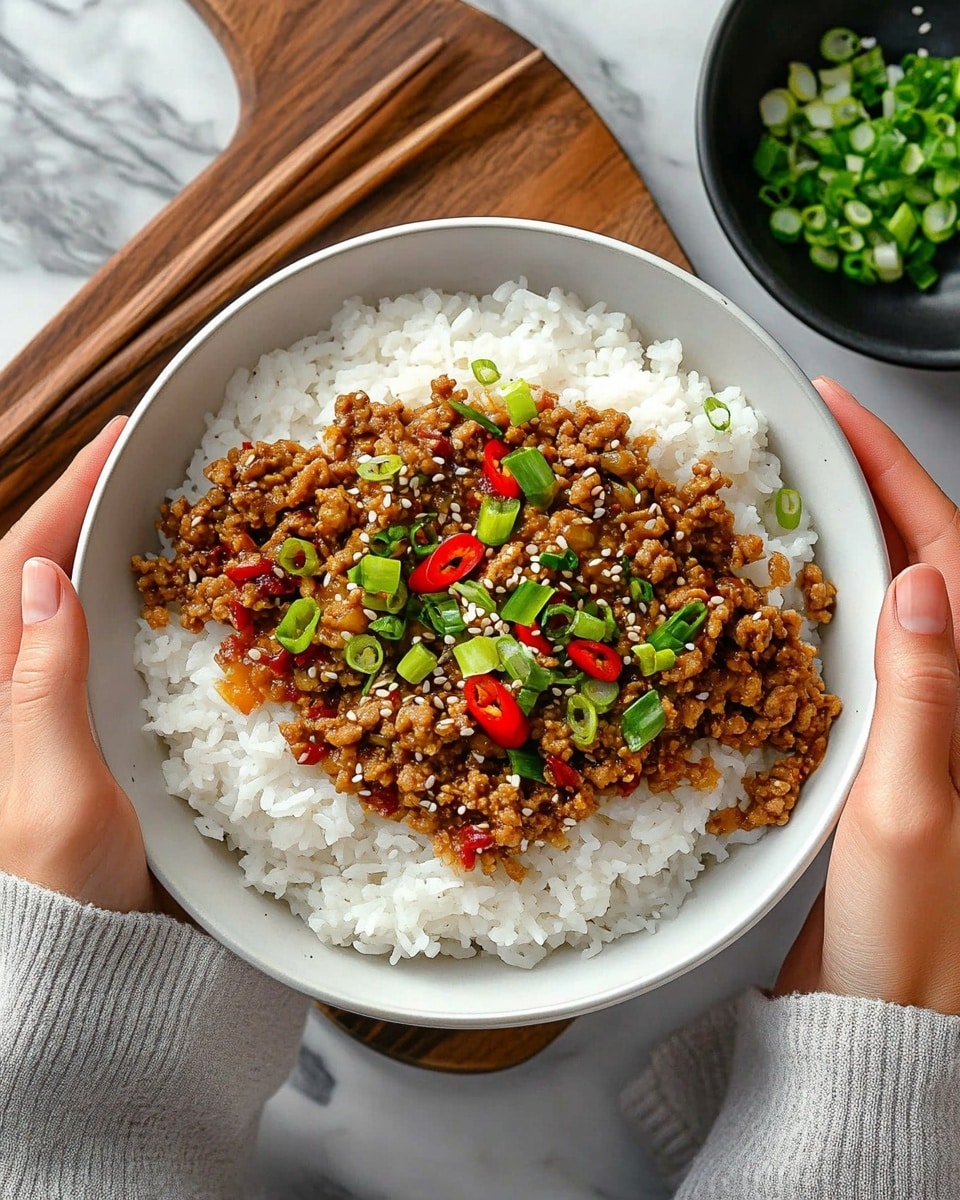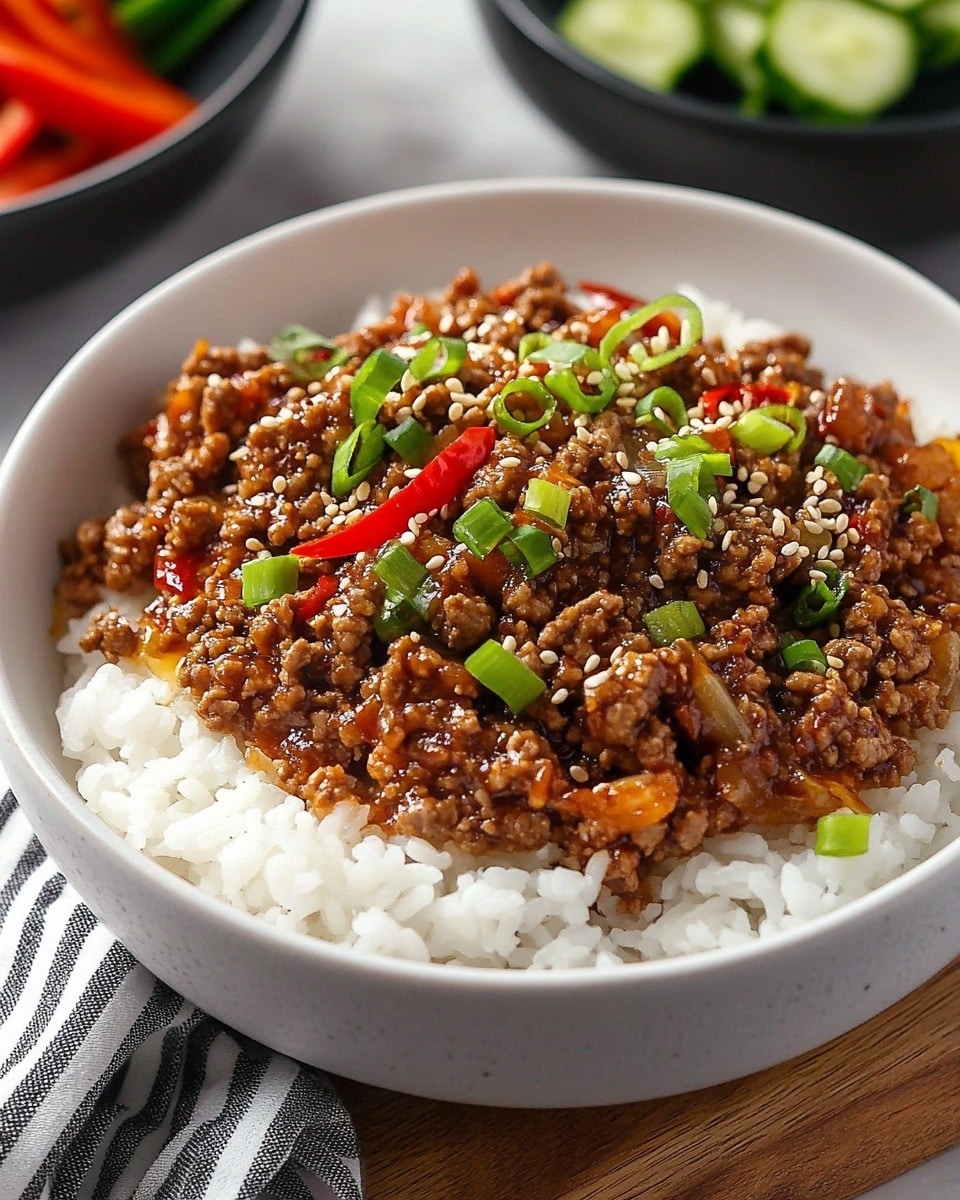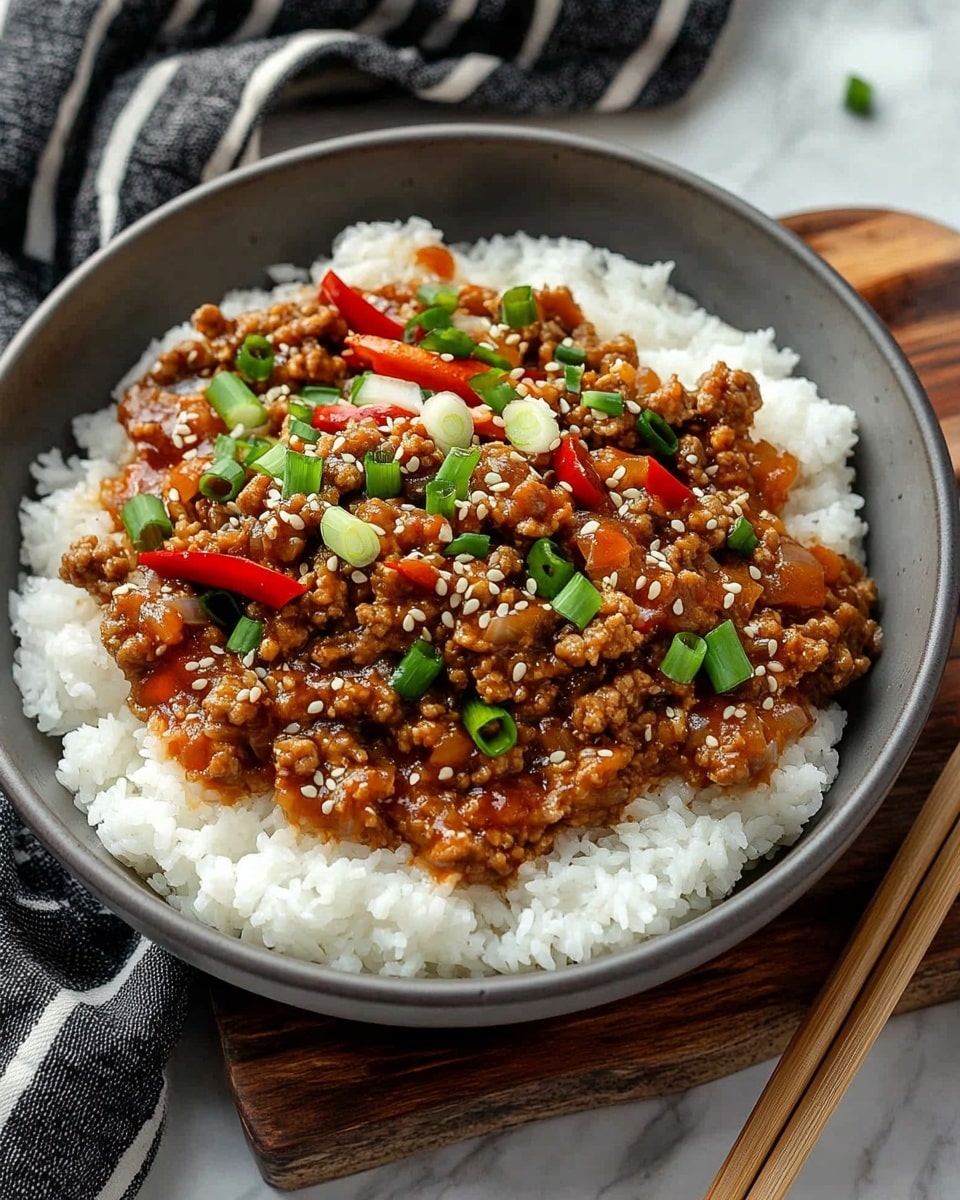If you’re craving something comforting yet bursting with bold, savory flavors, this Korean Beef Bowl Recipe is a fantastic choice. I absolutely love how this turns out every time – the rich, slightly spicy beef pairs perfectly with steamed rice, making it a meal that satisfies on so many levels. Whether you re looking for a quick weeknight dinner or a dish that warms you up on a chilly evening, this recipe fits the bill beautifully.
When I first tried this Korean Beef Bowl Recipe, what struck me was how simple ingredients come together to create such an authentic taste. The combination of gochujang and mirin adds that unique Korean punch without any complicated steps, so even if you re new to Korean cooking, you ll find this recipe both approachable and delicious. Trust me, your family will go crazy for this!
Why You’ll Love This Recipe
- Quick and Easy: Ready from start to finish in about 20 minutes, perfect for busy nights.
- Bold, Balanced Flavors: The sweet, salty, and spicy notes come together beautifully for an authentic Korean taste.
- Versatile Meal: Great as a stand-alone bowl or paired with your favorite sides for a fuller feast.
- Family Friendly: My kids love it, and it s easy to adjust spice levels to suit everyone s tastes.
Ingredients You’ll Need
The beauty of this Korean Beef Bowl Recipe lies in its straightforward ingredients that you probably have or can easily find. Each one plays a role to bring out deep and comforting flavors, so don t skip on the gochujang and mirin-they make a huge difference.
- Ground beef: I prefer 80/20 for some fat that keeps the beef juicy and flavorful.
- Onion (large sweet onion): Adds sweetness and texture; dice it finely so it cooks evenly.
- Garlic: Freshly grated garlic really gives that punch-don t use powdered here.
- Spring onions: Sliced thin for freshness and a nice mild onion flavor.
- Red chilli: Thin slices bring just enough heat and color without overwhelming the dish.
- Salt and black pepper: To season and balance flavors naturally.
- Toasted sesame seeds: Toast your own if you can! It makes a nutty difference.
- Vegetable oil: Any neutral oil like sunflower or canola works well to stir fry without overpowering.
- Light soy sauce: Essential for that salty umami base-avoid dark soy to keep it balanced.
- Mirin: Adds subtle sweetness and depth; if you don t have it, read the note below for substitutes.
- Gochujang: This Korean chili paste is key for authentic flavor; it s sweet, spicy, and fermented-hard to replace!
- Sesame oil: Just a teaspoon adds fragrant, toasty goodness.
- Sugar: Balances the savory and spicy flavors perfectly.
Variations
I love experimenting with this Korean Beef Bowl Recipe to keep things fresh. Depending on what you have on hand or your dietary preferences, you can easily customize it without losing that delicious Korean vibe.
- Protein swap: I ve swapped ground beef with ground turkey or chicken for a lighter version that still delivers on flavor.
- Vegetarian twist: Try crumbled firm tofu or tempeh with a dash more soy sauce and a pinch of smoked paprika for depth.
- Adding veggies: Bell peppers, shredded carrots, or mushrooms stir-fried with the onions add texture and color.
- Spice level: Adjust the amount of gochujang or chilli slices to suit your heat tolerance-my family enjoys a medium kick!
How to Make Korean Beef Bowl Recipe
Step 1: Mix Your Stir Fry Sauce
Start by combining the soy sauce, sesame oil, sugar, mirin, and gochujang in a small bowl. I usually whisk this until the sugar dissolves completely and the gochujang blends smoothly. Setting this aside early means it s ready to go as soon as the beef is cooked, making the process seamless.
Step 2: Prep the Veggies
While the sauce is settling, chop your onion into small dices, grate the garlic, and thinly slice the spring onions and red chili. Having everything already prepped is a game-changer here because stir-frying happens fast, and you won t want to be caught off guard trying to chop as you go.
Step 3: Stir Fry Onions and Garlic
Heat your wok or skillet over medium-high heat and drizzle in the vegetable oil. Toss in the onions first and stir them until they start to soften and become slightly translucent, about 2-3 minutes. Then, quickly add the grated garlic-just a few seconds to avoid burning-and stir together. This builds a fragrant base for the beef.
Step 4: Cook the Ground Beef
Add the ground beef, breaking it up with your spatula to crumble it evenly. Stir fry for about 3-4 minutes until the beef is browned and no longer pink. This step is key to developing that robust flavor you want-don t rush or crowd the pan, or you ll end up steaming the meat instead of browning it.
Step 5: Combine Beef with Sauce and Veggies
Whisk the sauce once more and pour it over the beef. Toss everything quickly to coat the meat evenly and let it cook with the sauce for another minute. Then stir in the chili slices and spring onions, cooking just long enough to warm them and release their aroma.
Step 6: Finish and Serve
Turn off the heat and sprinkle toasted sesame seeds on top. I always like to give it a quick taste now, adjusting salt if necessary. Serve immediately over hot steamed rice and garnish with extra spring onions and sesame seeds for a vibrant, delicious bowl.
Pro Tips for Making Korean Beef Bowl Recipe
- Don t Overcrowd the Pan: Cooking the beef in batches if needed helps you get a nice sear without steaming.
- Toast Sesame Seeds Fresh: I learned that freshly toasting the seeds in a dry pan before sprinkling makes the flavor pop way more.
- Prep Everything Before Cooking: Stir-fry moves fast, so having sauce and veggies ready ensures smooth workflow without rushing.
- Adjust Spicy Heat to Taste: When I first tried this, I added too much chili-start small and increase gradually to suit your palate.
How to Serve Korean Beef Bowl Recipe

Garnishes
I m a big fan of keeping it simple with extra chopped spring onions and toasted sesame seeds on top-these add freshness and a bit of crunch right at the end. Sometimes I also like adding a soft-boiled egg or a drizzle of extra sesame oil for richness.
Side Dishes
Pairing this with some quick kimchi or steamed greens balances the richness beautifully. My go-to sides also include cucumber salad with a little rice vinegar or pickled radishes to add brightness and a cool contrast.
Creative Ways to Present
For a special occasion, I love assembling the bowls with individual toppings like shredded carrots, sliced avocado, and a dollop of creamy mayo mixed with a pinch of gochujang for a spicy kick. It transforms this humble bowl into something visually stunning and extra flavorful.
Make Ahead and Storage
Storing Leftovers
I store leftover Korean beef in an airtight container in the fridge for up to 3 days. I find that letting it cool completely before sealing helps keep the flavors fresh and prevents sogginess when you reheat.
Freezing
If you want to freeze it, portion the beef into freezer-safe bags or containers. I usually freeze cooked beef without the rice, and it keeps well for up to 2 months. Just thaw overnight in the fridge before reheating.
Reheating
Reheat leftovers gently in a skillet over medium heat to avoid drying it out. You can add a splash of water or a few drops of oil if it seems dry. Microwave works in a pinch but stir halfway through to ensure even heating.
FAQs
-
What can I substitute for gochujang in the Korean Beef Bowl Recipe?
Gochujang is quite unique, but if you can’t find it, you can try using Thai Sriracha sauce or a combination of miso paste and a bit of chili powder. Just note the flavor will be different, but you ll still get a spicy, umami kick.
-
Can I use a different type of meat in this Korean Beef Bowl Recipe?
Absolutely! Ground turkey, chicken, or pork all work well as substitutes. Just cook them similarly, and you might want to adjust seasoning slightly to balance the flavors.
-
Is this Korean Beef Bowl Recipe spicy?
The heat level is moderate due to the gochujang and fresh chili slices. If you want it milder, reduce or skip the chili slices; for more spice, add extra gochujang or chili.
-
How do I make this recipe gluten-free?
Use tamari or a gluten-free soy sauce substitute in place of regular soy sauce, and check the gochujang label to ensure it s gluten-free. This way, you can enjoy all the flavors without the gluten.
Final Thoughts
This Korean Beef Bowl Recipe has quickly become one of my favorite go-to meals because it s so easy, flavorful, and satisfying. I recommend giving it a try even if you re new to Korean cooking-you ll be surprised how uncomplicated and rewarding it is. Once you make it, I bet you ll be reaching for it again and again, just like I do!
Print
Korean Beef Bowl Recipe
- Prep Time: 10 minutes
- Cook Time: 10 minutes
- Total Time: 20 minutes
- Yield: 2 servings
- Category: Dinner
- Method: Stovetop
- Cuisine: Korean
Description
This Korean Beef Bowl is a quick and flavorful dinner recipe featuring ground beef stir-fried with aromatic garlic, onions, and a spicy, savory sauce made from gochujang, soy sauce, mirin, and sesame oil. Served over steamed rice and garnished with spring onions and toasted sesame seeds, it’s a comforting and satisfying Asian-inspired meal perfect for busy weeknights.
Ingredients
For the Beef Bowl
- 10 oz Ground beef (about 280-300 grams)
- 1/2 large sweet onion, cut into small dices
- 1 tbsp Garlic, grated
- 3 Spring onions, thinly sliced
- 1 Red chilli, thinly sliced
- Salt, to taste
- 1/4 tsp Black pepper
- 1 tbsp Toasted sesame seeds
- 2 tbsp Vegetable oil (sunflower, canola, peanut, or vegetable oil)
For the Stir Fry Sauce
- 2 tbsp Light soy sauce
- 1 tbsp Mirin (Japanese rice cooking wine; see notes for substitutes)
- 1 tbsp Gochujang (Korean fermented chili paste; see notes for substitutes)
- 1 tsp Sesame oil
- 1 tbsp Sugar
Instructions
- Prepare the Sauce: In a small mixing bowl, combine soy sauce, sesame oil, sugar, mirin, and gochujang. Mix well until the sugar and gochujang are fully dissolved. Set the sauce aside.
- Prepare the Vegetables: Finely chop the garlic, dice the onion, thinly slice the spring onions and red chilli to have all ready for cooking.
- Cook the Aromatics: Heat a wok or large pan over medium-high heat and add 2 tablespoons of vegetable oil. Add the diced onions and stir-fry until they become slightly tender. Add the grated garlic and stir for a few seconds until fragrant.
- Cook the Beef: Add the ground beef to the pan and stir-fry for 3-4 minutes, breaking it apart, until it is mostly cooked and no longer pink.
- Add the Sauce: Whisk the prepared sauce again briefly, then pour it evenly over the cooked beef. Toss everything quickly to combine the flavors thoroughly.
- Finish Cooking: Add the sliced red chilli and spring onions. Continue stir-frying for another minute, letting the flavors meld.
- Garnish and Serve: Turn off the heat and sprinkle the toasted sesame seeds over the beef. Transfer to a serving plate and serve immediately over hot steamed rice. Optionally, top with extra chopped spring onions and toasted sesame seeds for added flavor and texture.
Notes
- Mirin: A Japanese rice cooking wine. If you do not have mirin, substitute with dry sherry, sweet marsala wine, or Chinese Shao Xing cooking rice wine. For a non-alcoholic alternative, omit mirin or use a splash of rice vinegar with a dash of sugar.
- Gochujang: Korean fermented chili pepper paste, key to authentic flavor. If unavailable, substitute with other chili sauces like Thai Sriracha for a similar spicy kick, though the flavor will differ.
Nutrition
- Serving Size: 1 bowl (approx. half recipe)
- Calories: 580 kcal
- Sugar: 12 g
- Sodium: 1173 mg
- Fat: 45 g
- Saturated Fat: 23 g
- Unsaturated Fat: 22 g
- Trans Fat: 0 g
- Carbohydrates: 19 g
- Fiber: 1 g
- Protein: 28 g
- Cholesterol: 101 mg









